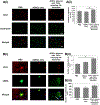Surface Tethering of Inflammation-Modulatory Nanostimulators to Stem Cells for Ischemic Muscle Repair
- PMID: 32243129
- PMCID: PMC8274413
- DOI: 10.1021/acsnano.9b04926
Surface Tethering of Inflammation-Modulatory Nanostimulators to Stem Cells for Ischemic Muscle Repair
Abstract
Stem cell transplantation has been a promising treatment for peripheral arterial diseases in the past decade. Stem cells act as living bioreactors of paracrine factors that orchestrate tissue regeneration. Prestimulated adipose-derived stem cells (ADSCs) have been proposed as potential candidates but have been met with challenges in activating their secretory activities for clinical use. Here, we propose that tethering the ADSC surface with nanoparticles releasing tumor necrosis factor α (TNFα), named nanostimulator, would stimulate cellular secretory activity in situ. We examined this hypothesis by complexing octadecylamine-grafted hyaluronic acid onto a liposomal carrier of TNFα. Hyaluronic acid increased the liposomal stability and association to CD44 on ADSC surface. ADSCs tethered with these TNFα carriers exhibited up-regulated secretion of proangiogenic vascular endothelial growth factor and immunomodulatory prosteoglandin E2 (PGE2) while decreasing secretion of antiangiogenic pigment epithelium-derived factors. Accordingly, ADSCs tethered with nanostimulators promoted vascularization in a 3D microvascular chip and enhanced recovery of perfusion, walking, and muscle mass in a murine ischemic hindlimb compared to untreated ADSCs. We propose that this surface tethering strategy for in situ stimulation of stem cells would replace the costly and cumbersome preconditioning process and expedite clinical use of stem cells for improved treatments of various injuries and diseases.
Keywords: adipose-derived stem cells; angiogenesis; hyaluronic acid; liposome; muscle; vascular endothelial growth factor.
Conflict of interest statement
The authors declare no competing financial interest.
Figures











Similar articles
-
Shear-Resistant, Biological Tethering of Nanostimulators for Enhanced Therapeutic Cell Paracrine Factor Secretion.ACS Appl Mater Interfaces. 2021 Apr 21;13(15):17276-17288. doi: 10.1021/acsami.1c01520. Epub 2021 Apr 8. ACS Appl Mater Interfaces. 2021. PMID: 33830733 Free PMC article.
-
Glyoxalase-1 Overexpression Reverses Defective Proangiogenic Function of Diabetic Adipose-Derived Stem Cells in Streptozotocin-Induced Diabetic Mice Model of Critical Limb Ischemia.Stem Cells Transl Med. 2017 Jan;6(1):261-271. doi: 10.5966/sctm.2015-0380. Epub 2016 Aug 15. Stem Cells Transl Med. 2017. PMID: 28170200 Free PMC article.
-
Synergistic angiogenesis promoting effects of extracellular matrix scaffolds and adipose-derived stem cells during wound repair.Tissue Eng Part A. 2011 Mar;17(5-6):725-39. doi: 10.1089/ten.TEA.2010.0331. Epub 2010 Dec 18. Tissue Eng Part A. 2011. PMID: 20929282
-
Adipose tissue-derived stem cells as a therapeutic tool for cardiovascular disease.World J Cardiol. 2015 Aug 26;7(8):454-65. doi: 10.4330/wjc.v7.i8.454. World J Cardiol. 2015. PMID: 26322185 Free PMC article. Review.
-
The wound-healing and antioxidant effects of adipose-derived stem cells.Expert Opin Biol Ther. 2009 Jul;9(7):879-87. doi: 10.1517/14712590903039684. Expert Opin Biol Ther. 2009. PMID: 19522555 Review.
Cited by
-
The Promise of Emergent Nanobiotechnologies for In Vivo Applications and Implications for Safety and Security.Health Secur. 2022 Sep-Oct;20(5):408-423. doi: 10.1089/hs.2022.0014. Health Secur. 2022. PMID: 36286588 Free PMC article.
-
Stem cell therapy: A promising therapeutic approach for skeletal muscle atrophy.World J Stem Cells. 2025 Feb 26;17(2):98693. doi: 10.4252/wjsc.v17.i2.98693. World J Stem Cells. 2025. PMID: 40061264 Free PMC article. Review.
-
Synergistic effect of Hypoxic Conditioning and Cell-Tethering Colloidal Gels enhanced Productivity of MSC Paracrine Factors and Accelerated Vessel Regeneration.Adv Mater. 2025 Jan;37(3):e2408488. doi: 10.1002/adma.202408488. Epub 2024 Oct 9. Adv Mater. 2025. PMID: 39380372
-
Strategies for improving adipose-derived stem cells for tissue regeneration.Burns Trauma. 2022 Aug 16;10:tkac028. doi: 10.1093/burnst/tkac028. eCollection 2022. Burns Trauma. 2022. PMID: 35992369 Free PMC article. Review.
-
Mechanistic insights into adipose-derived stem cells and exosomes in ischemia-reperfusion injury repair: from shared pathways to organ-specific therapeutics.Front Cell Dev Biol. 2025 Jun 20;13:1621289. doi: 10.3389/fcell.2025.1621289. eCollection 2025. Front Cell Dev Biol. 2025. PMID: 40620764 Free PMC article. Review.
References
-
- Ito WD; Arras M; Winkler B; Scholz D; Schaper J; Schaper W Monocyte Chemotactic Protein-1 Increases Collateral and Peripheral Conductance after Femoral Artery Occlusion. Circ. Res 1997, 80, 829–837. - PubMed
-
- Spaggiari GM; Abdelrazik H; Becchetti F; Moretta L MSCs Inhibit Monocyte-Derived DC Maturation and Function by Selectively Interfering with the Generation of Immature DCs: Central Role of MSC-Derived Prostaglandin E2. Blood 2009, 113, 6576–6583. - PubMed
Publication types
MeSH terms
Substances
Grants and funding
LinkOut - more resources
Full Text Sources
Medical
Miscellaneous

